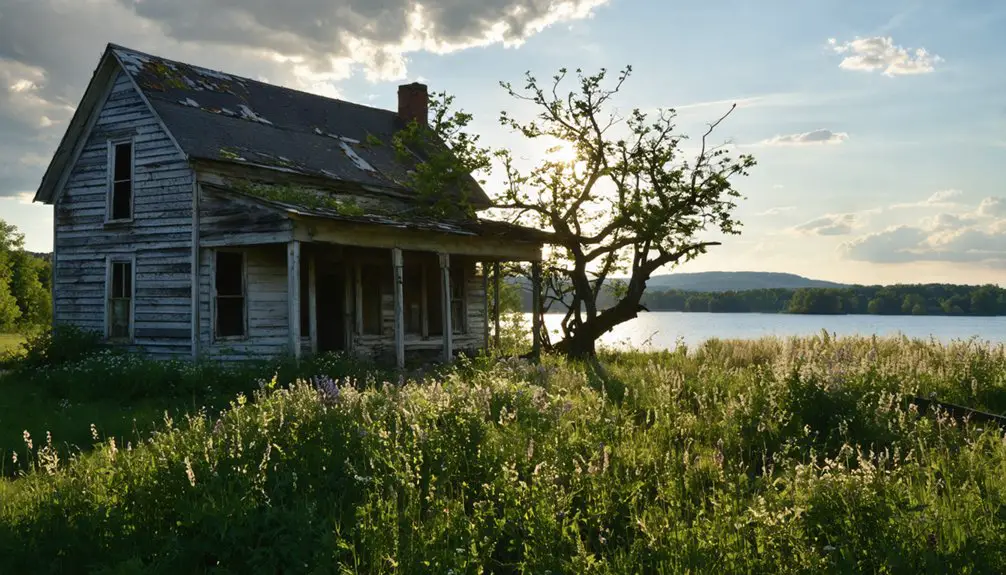While Isle La Motte isn’t a traditional ghost town, you’ll find fascinating traces of Vermont’s first European settlement, Fort Ste Anne, established in 1666. This French military outpost, featuring a 15-foot double log palisade, was deliberately destroyed in 1676 and vanished from the landscape. Today, you can explore the historic grounds near Saint Anne’s Shrine, where archaeological discoveries have unearthed colonial artifacts like knives and pottery, revealing layers of hidden history beneath your feet.
Key Takeaways
- Isle La Motte is not a ghost town, maintaining an active population of approximately 488 year-round residents as of recent data.
- Fort Ste Anne, established in 1666, became abandoned after deliberate destruction in 1676, creating the island’s first ghost settlement.
- The island experienced population decline after peak limestone quarrying operations, but maintained continuous habitation since permanent settlement in 1785.
- Despite economic challenges and a -0.4% annual population decline, the island sustains tourism, agriculture, and religious pilgrimage activities.
- The island’s historical settlement areas remain inhabited, with Saint Anne’s Shrine and active community services contradicting ghost town status.
The Lost Fort Ste Anne Settlement
While many early colonial settlements have left lasting physical traces, Fort Ste Anne on Isle La Motte‘s northwest shore has completely vanished into history. Built in 1666 by Captain Sieur de La Motte’s French soldiers, this fort architecture featured an imposing 15-foot-high double log palisade with four bastions, spanning 144 by 96 feet.
You won’t find any remnants today – the French deliberately destroyed it in 1676 to prevent enemy occupation. The fort was part of a strategic line of forts along the Richelieu River designed to protect New France.
The fort marked Vermont’s first European settlement and served as a significant defensive point against the Iroquois. Despite its short life, it played an essential role in indigenous relations, hosting 600 Carignan soldiers and 100 Huron warriors for military expeditions. The fort’s location on the northernmost inhabited island in Lake Champlain made it strategically important for controlling water routes.
Historical Evolution of Isle La Motte
You’ll find the earliest European settlement at Isle La Motte in Fort Ste Anne, established by the French in 1666 as a strategic military outpost on Lake Champlain’s northernmost island.
Though the fort’s wooden structure vanished by the mid-1800s, its legacy marked the beginning of Vermont’s European settlement nearly a century before colonization elsewhere in the region.
The island’s permanent community took root around 1785 when settlers like Ebenezer Hyde and William Blanchard arrived, leading to its official incorporation as a town in 1878. The town’s economy flourished when the Fisk Quarry began exporting its distinctive dark limestone in 1832. The fertile soil proved especially suitable for fruit production, generating significant value for local farmers.
Early French Military Settlement
In 1666, Fort Sainte Anne emerged as Vermont’s first permanent European settlement when French soldiers of the Carignan-Salières Regiment, under Captain Sieur de La Motte’s command, established a strategic outpost on Isle La Motte’s northwest shore.
The French settlement featured a 15-foot double log palisade with four bastions, spanning roughly 144 by 96 feet. You’ll find it served as a vital military staging ground, where 600 Carignan veterans, French volunteers, and Huron warriors gathered to launch campaigns against the British and Iroquois. King Louis XV granted multiple land holdings in the surrounding area to encourage settlement growth. A dedicated chapel site served as the location where the first Mass in the Northeast was celebrated.
The fort’s military strategies centered on controlling Lake Champlain and protecting French interests. From this northern outpost, about 300 bateaux and bark canoes departed for expeditions, while a chapel on-site reinforced both religious and territorial claims.
Community Growth Since 1779
After Fort Sainte Anne’s abandonment, Isle La Motte remained largely uninhabited until October 27, 1779, when Vermont chartered it as part of the Lake Champlain Islands.
Early settlement patterns emerged around 1785, with pioneers like Ebenezer Hyde and William Blanchard establishing the first farms.
You’ll find that community demographics shifted as the island’s economy evolved. While farming dominated the late 18th century, the discovery of valuable limestone led to thriving quarry operations by 1788. The quarries provided “Fisk black” and “French gray” stone for notable projects, including the U.S. Capitol.
The 1882 bridge to Alburgh strengthened mainland connections, transforming the island’s isolation. Today’s year-round population of 500 reflects a diverse community that’s moved beyond its agricultural and quarrying roots to embrace tourism, preservation, and educational initiatives.
Local Legends and Lake Mysteries
Legends and mysteries permeate Isle La Motte’s rich history, from the haunting tales of Fort Ste. Anne to the eerie lake apparitions that still captivate visitors today.
You’ll find ghostly remnants of the fort’s troubled past, where soldiers endured harsh isolation before abandoning the site in 1671. Their spirits, according to local lore, continue to wander the grounds of Saint Anne’s Shrine.
The lake itself holds its own dark secrets. You might hear about Eleanor Fisk’s mysterious drowning and the old Yankee tradition of using cloaks to locate missing persons in Lake Champlain’s depths.
Near Noisy Beach, named after this very legend, you’ll encounter stories of strange sounds and unexplained phenomena that blend seamlessly with the island’s natural beauty and historic significance. Beneath the surface lies the world’s oldest coral reef, a 480-million-year-old testament to the island’s mysterious past.
Geological Wonders and Ancient Reefs
Deep beneath Isle La Motte’s surface lies one of Earth’s most remarkable ancient treasures – a 480-million-year-old reef that once thrived in tropical waters near present-day Morocco.
Originally formed when this region was submerged in the warm Iapetus Ocean, these limestone formations tell a fascinating story of Earth’s past.
You’ll find this geological wonder packed with ancient marine fossils, from primitive sponges to mysterious stromatolites, preserved in thick beds of black limestone. While fossil exploration reveals countless prehistoric creatures, the reef’s robust structure helped it survive glacial erosion during the last Ice Age.
Since 1832, limestone quarrying has shaped the island’s legacy. The distinctive black stone, often called “black marble,” adorns prestigious buildings like the U.S. Capitol and National Gallery of Art. Today, the Goodsell Ridge Preserves offers visitors a unique glimpse into this geological history.
You can still spot this ancient reef’s remnants in local structures, including the Methodist Church and Public Library, connecting you directly to Earth’s distant past.
Economic Transformation Through Time

If you’d visited Isle La Motte in 1788, you’d have found a bustling economy centered on black marble quarrying and farming, with the famous “Champlain black” stone being shipped to prestigious buildings like the U.S. Capitol.
The island’s economic landscape transformed dramatically when quarry operations ceased in the mid-1960s, marking the end of an era that had provided steady employment for generations of workers.
Today, you’ll find Isle La Motte’s economy largely sustained by heritage tourism, with visitors drawn to its fossil reefs and historic sites, while small-scale farming continues to play a supporting role in the local market.
Early Industries and Commerce
Three major industries shaped Isle La Motte’s early economic landscape: quarrying, agriculture, and maritime trade.
The quarrying legacy began in 1664 with the extraction of black limestone, marketed as “Fisk black” and “Champlain black,” which you’ll find in prestigious buildings like the U.S. Capitol. You’ll notice this legacy in the island’s stone buildings, constructed entirely from local fossiliferous limestone.
Agricultural practices flourished after 1779, with farming families adapting to the limestone-rich soils through mixed cultivation and apple orchards. By the 1890s, they’d embraced scientific methods like grafting to enhance apple production. The island’s apple industry reached its peak in 1896 when Isle La Motte produced an impressive 15,000 barrels of apples.
The island’s maritime commerce got a significant boost when the Champlain Canal opened in 1823, transforming local trade as merchants shipped lumber, potash, and agricultural goods via Lake Champlain’s waters.
Modern Tourism Revenue Growth
While Isle La Motte‘s historic industries have faded, tourism now drives the island’s economic engine, especially during summer months when the population swells beyond its 488 year-round residents.
Tourism trends show significant seasonal peaks, with visitors flocking to the island’s natural beauty, Fort Sainte Anne, and Saint Anne’s Shrine.
Visitor demographics reflect a mix of seasonal homeowners, family members of the island’s aging population, and heritage tourists drawn to historical sites.
You’ll find expanded services catering to these visitors, including boat rentals, guided tours, and local craft sales.
The town’s commitment to infrastructure improvements, like enhanced roads and visitor centers, supports this growth while preserving Isle La Motte’s unique character.
Lake Champlain’s recreational opportunities further boost the island’s appeal as a tourism destination.
Saint Anne’s Shrine and Cultural Heritage
Located on Isle La Motte’s historic shores, Saint Anne’s Shrine stands as Vermont’s oldest Catholic religious site, tracing its origins to the 1666 construction of Fort Sainte Anne by French forces.
The shrine’s cultural significance extends beyond its military beginnings – it marks the spot of Vermont’s first Catholic Mass and witnessed early Native American baptisms under Bishop François de Laval in 1668.
You’ll find archaeological treasures unearthed by Father Kerlidou in 1892, including knives, pottery, and artifacts that tell the story of both indigenous and French colonial presence.
Today, the 1893 chapel and prominent Saint Anne statue continue to draw visitors for religious pilgrimage and reflection.
The site’s enduring legacy connects modern-day faithful to centuries of spiritual practice, from early Iroquois converts to contemporary worshippers.
Modern Life on a Historic Island
Despite its rich historical legacy, modern Isle La Motte presents a portrait of small-town Vermont life with just under 500 residents.
You’ll find a tight-knit community where the median age hovers around 42, reflecting modern challenges of retaining younger residents while supporting an aging population.
Living on this historic island means adapting to unique demands of island sustainability. The community’s workforce shoulders a significant dependency ratio of 80, supporting both youth and elderly populations.
While median household incomes reach $69,000, you’ll notice economic disparities with poverty rates touching 15% in some areas.
The mostly white population maintains close connections through necessity and tradition, even as the community faces declining numbers at -0.4% annually.
Modern infrastructure keeps residents connected to mainland opportunities while preserving their distinct island identity.
Frequently Asked Questions
What Transportation Options Exist to Reach Isle La Motte During Winter Months?
You’ll find winter accessibility via maintained highways for personal vehicles, or you can combine bus service from Burlington with taxi transfers. Travel logistics require planning around winter conditions and limited public transit.
Are There Any Restrictions on Fossil Collecting at the Quarry Sites?
You can’t collect fossils at these protected quarries – it’s strictly prohibited. The preserves’ fossil regulations and quarry access rules focus on observation only, preserving specimens for research and education.
Where Can Visitors Find Overnight Accommodations on the Island?
You’ll find comfortable stays at Ruthcliffe Lodge, Inn at the Isles, Old Schoolhouse B&B, Maya Retreat Center, and Fisk Farm. While camping options aren’t available, these local inns provide charming hospitality.
What Native American Tribes Originally Inhabited Isle La Motte?
You’ll find the Abenaki and Mohican tribes were the primary Native American inhabitants, with historical significance dating back centuries. The Western Abenaki specifically dominated the northern Champlain Basin by the 1640s.
Do Any Original French Settler Descendants Still Live on the Island?
Though French settler heritage once marked Vermont’s first European settlement in 1666, you won’t find documented family connections to original Fort Ste Anne inhabitants on the island today – those lineages weren’t preserved.
References
- https://islelamotte.us/community/historical-society/
- https://obscurevermont.com/mysteries-and-legends-of-the-champlain-islands/
- https://islelamotte.us/community/about-our-island/
- https://www.lakechamplainregion.com/story/2015/10/haunted-lake
- http://freepages.rootsweb.com/~gtusa/history/usa/vt.htm
- https://fortwiki.com/Fort_Sainte_Anne_(1)
- https://www.hmdb.org/m.asp?m=74721
- https://www.saintannesshrine.org/history
- https://vermonthistory.org/fort-sainte-anne
- https://sites.rootsweb.com/~vermont/GrandIsleIsleLaMotte.html



